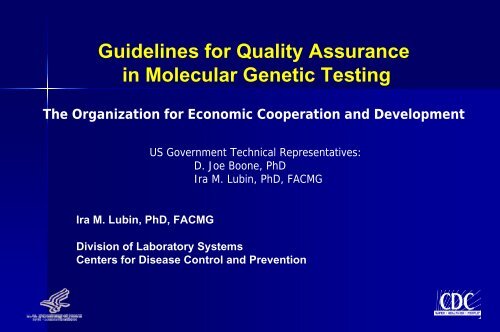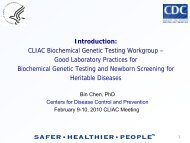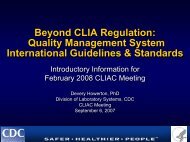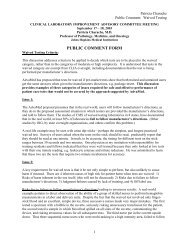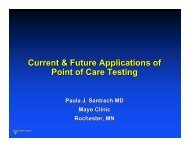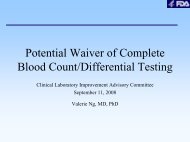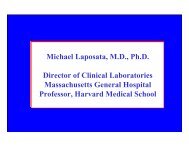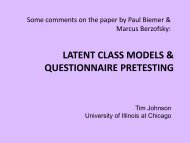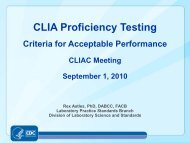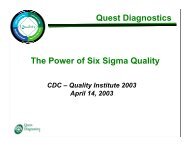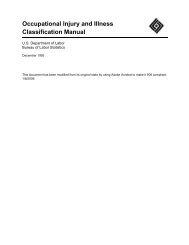OECD Guidelines for Quality Assurance in Molecular Genetic Testing
OECD Guidelines for Quality Assurance in Molecular Genetic Testing
OECD Guidelines for Quality Assurance in Molecular Genetic Testing
- No tags were found...
You also want an ePaper? Increase the reach of your titles
YUMPU automatically turns print PDFs into web optimized ePapers that Google loves.
What is theOrganization <strong>for</strong> Economic Cooperation and Development?(<strong>OECD</strong>)• Governmental Organization - established <strong>in</strong> 1961• Orig<strong>in</strong> traced to post-WWII Marshal Plan• 30 member countries + cooperative arrangements with 70+ others• Focus is to promote economic growth and f<strong>in</strong>ancial stability• Biotechnology and health care viewed as key sectors• <strong>Molecular</strong> genetic test<strong>in</strong>g viewed as important and evolv<strong>in</strong>g• Lack of an <strong>in</strong>ternational frameworkhttp://www.oecd.org
The Journey to Guidel<strong>in</strong>e DevelopmentFocus: <strong>Molecular</strong> genetic test<strong>in</strong>g <strong>for</strong> medical (disease-related) conditions<strong>OECD</strong> GUIDELINEFOR QUALITY ASSURANCEiN MOLECULAR GENETICTESTING200020052007
<strong>Quality</strong> <strong>Assurance</strong> and Proficiency Test<strong>in</strong>g<strong>for</strong> <strong>Molecular</strong> <strong>Genetic</strong> Test<strong>in</strong>g(Evidence <strong>for</strong> Policy Development)Total:US:827 Responses226 Responses2005http://www.oecd.org/dataoecd/25/12/34779945.pdf
Laboratory Practice Sett<strong>in</strong>gs(from the survey)12%20%8%4%4%16%20%22%38%56%IndependentPrivate HospitalPublic Hospialublic Non-HospitalsResearch60%50%40%30%20%10%0%AllLaboratoriesUSLaboratoriesSett<strong>in</strong>g% Labs<strong>in</strong> one or more sett<strong>in</strong>gs
SpecimensProcessedSpecimens Processed <strong>for</strong> Test<strong>in</strong>g(from the survey)1,600,0001,400,0001,200,0001,000,000800,000600,000400,000200,000874,6081,112,9881,401,536167,649205,860279,744AllLaboratoriesUSLaboratories02000 2001 2002Year
Cross-Border Flow of Samples(from the survey)In 2002Number of samples sent out of countryTotal: 18,000US: 5030Percentage of laboratories send<strong>in</strong>g samplesout of countryAll Countries: 67% (554 out of 827)US: 28% (63 out of 226)
<strong>Quality</strong> <strong>Assurance</strong> IndexIn<strong>for</strong>mation elementStandard operat<strong>in</strong>gProcedures developedStandard operat<strong>in</strong>gprocedures reviewed bydirectorLaboratory report isissuedReport is reviewed bydirectorTurnaround time data iscollected% Total comply<strong>in</strong>g(n=827)9482958481% US comply<strong>in</strong>g(n=226)8898969483
General elementsReport<strong>in</strong>g <strong>Quality</strong> Index% Total comply<strong>in</strong>g % US comply<strong>in</strong>gBasic ElementsTwo unique identifiers 100100Result 95 92Added SpecificityDate of Birth 88 100Reason <strong>for</strong> test<strong>in</strong>g 89 94Statement of limitations 78 79Director’s s signature 84 94Implications <strong>for</strong> other familymembersAlso Useful61 64Date of report 99 100Sample collection date 86 98Suggestion <strong>for</strong> further test<strong>in</strong>g 82 79
Variables associated with higher quality <strong>in</strong>dices• Standard Operat<strong>in</strong>g Procedures exist• Standard operat<strong>in</strong>g procedures are reviewed by director• Laboratory test result report is issued (written or electronic)• Laboratory test result report is reviewed by director• Offer<strong>in</strong>g of prenatal / pre-implantation test<strong>in</strong>g• Affiliation with a genetics unit• Licens<strong>in</strong>g and accreditation• Participation <strong>in</strong> proficiency test<strong>in</strong>g• Not primarily <strong>in</strong> a research sett<strong>in</strong>g• Ma<strong>in</strong>ta<strong>in</strong><strong>in</strong>g data on turnaround time• Lab director has an MD or PhD• Lab director is certified• Lab director has <strong>for</strong>mal tra<strong>in</strong><strong>in</strong>g• Lab technicians have a university degree• lab technicians have relevant tra<strong>in</strong><strong>in</strong>g
Official Recognition of LaboratoriesAll countriesUSLicensed / Certified 49% 98%Accredited 54% 84%Barriers to Accreditation(one or more reasons given)All countriesn=362USn=23In process 8% 14%Cost too high 64% 54%Not required 46% 45%Other 28% 14%
Guidel<strong>in</strong>e <strong>for</strong> <strong>Quality</strong> <strong>Assurance</strong><strong>in</strong> <strong>Molecular</strong> <strong>Genetic</strong> Test<strong>in</strong>g"Prior to <strong>for</strong>m acceptance by theUS and other countries of the <strong>OECD</strong>.there was a significant commentperiod and <strong>for</strong>mal discussion"http://www.oecd.org/dataoecd/43/6/38839788.pdf
<strong>OECD</strong> <strong>Guidel<strong>in</strong>es</strong> <strong>for</strong> <strong>Quality</strong> <strong>Assurance</strong><strong>in</strong> <strong>Molecular</strong> <strong>Genetic</strong> Test<strong>in</strong>g• Promote m<strong>in</strong>imum standards• Facilitate mutual recognition of quality assurance frameworks• Strengthen <strong>in</strong>ternational co-operation to facilitate cross-borderflow of patient specimens <strong>for</strong> medically necessary test<strong>in</strong>g• Increase public confidence <strong>in</strong> the governance of moleculargenetic test<strong>in</strong>g
<strong>OECD</strong> <strong>Guidel<strong>in</strong>es</strong> <strong>for</strong> <strong>Quality</strong> <strong>Assurance</strong><strong>in</strong> <strong>Molecular</strong> <strong>Genetic</strong> Test<strong>in</strong>gComponents1. General pr<strong>in</strong>ciples and best practices2. <strong>Quality</strong> assurance systems3. Proficiency test<strong>in</strong>g4. <strong>Quality</strong> of result report<strong>in</strong>g5. Education and tra<strong>in</strong><strong>in</strong>g standards6. AnnotationsOrganization:Pr<strong>in</strong>ciples (1,2,3...): Primarily directed to governmentsBest Practices (i, ii, iii): Primarily directed to laboratories and other entities
General pr<strong>in</strong>ciples and best practicesA.2 - <strong>Molecular</strong> genetic test<strong>in</strong>g should be delivered with<strong>in</strong> the framework ofhealthcare.A.i - Regulatory/professional bodies should, as appropriate, review whether<strong>in</strong>struments available to manage a quality assurance frameworkrequire adaptation <strong>for</strong> molecular genetic test<strong>in</strong>gA.3 - All molecular genetic test<strong>in</strong>g services should be provided andpractices under a quality assurance frameworkA.iii - <strong>Molecular</strong> genetic test results should be reported back to thereferr<strong>in</strong>g health care professional to enable counsel<strong>in</strong>g andhealthcare decision mak<strong>in</strong>g
<strong>Quality</strong> <strong>Assurance</strong> Systems<strong>in</strong> <strong>Molecular</strong> <strong>Genetic</strong> Test<strong>in</strong>gB.1 - Governments and regulatory bodies should recognize thataccreditation of medical laboratories is an effective procedure<strong>for</strong> assur<strong>in</strong>g quality.B.i. - All laboratories report<strong>in</strong>g molecular genetic test<strong>in</strong>g results <strong>for</strong>cl<strong>in</strong>ical care purposes should be accredited or hold anequivalent recognition. (additional clarification <strong>for</strong> roleof research laboratories)B.9 - Governments should encourage <strong>in</strong>ternational collaboration <strong>for</strong>the development and validation of molecular genetic tests.B.viii - Laboratories should cooperative (<strong>in</strong>ternationally) to collect,develop, verify and make available reference materials.
Proficiency Test<strong>in</strong>g:Monitor<strong>in</strong>g the <strong>Quality</strong> of Laboratory Per<strong>for</strong>manceC.1 - The per<strong>for</strong>mance of laboratories offer<strong>in</strong>g cl<strong>in</strong>ical molecular genetictests should be measured.C.iii - Proficiency test<strong>in</strong>g schemes should be structured to assess allphases of the laboratory process, <strong>in</strong>clud<strong>in</strong>g result report<strong>in</strong>g.C.4 - Accreditation or equivalent recognition should be the basis <strong>for</strong> the<strong>in</strong>ternational recognition of proficiency test<strong>in</strong>g scheme andproviders.C.v - Laboratories should participate <strong>in</strong> a proficiency test<strong>in</strong>g scheme <strong>for</strong>every test offered, when such schemes exist. When not available,they should participate <strong>in</strong> alternate methods.
<strong>Quality</strong> of Result Report<strong>in</strong>gD.1 - All laboratories should issue molecular genetic test<strong>in</strong>g results<strong>in</strong> the <strong>for</strong>m of a written and/or electronic report to thereferr<strong>in</strong>g health professionalD.i - Reports should communicate <strong>in</strong><strong>for</strong>mation effectively tak<strong>in</strong>g <strong>in</strong>toaccount that the recipient may not be a specialist.D.2 - Where reports are issued directly to patients, it should beencouraged that laboratories recommend consultationwith an appropriate health care professional.D.4 - The <strong>in</strong>terpretation of the result should be appropriate to the<strong>in</strong>dividual and cl<strong>in</strong>ical situation and based on objectiveevidence.
Education and Tra<strong>in</strong><strong>in</strong>gStandards <strong>for</strong> Laboratory PersonnelE.2 - Standards <strong>for</strong> laboratory accreditation or other equivalentrecognition should require that all molecular geneticspersonnel have a comb<strong>in</strong>ation of education, tra<strong>in</strong><strong>in</strong>g, skills,and experience that ensures their competence.E.4 - Development of educational and tra<strong>in</strong><strong>in</strong>g programmes should beencouraged where they do not exist.E.vi. Comparison of education and tra<strong>in</strong><strong>in</strong>g systems between jurisdictionsshould be facilitated as a means to establish equivalence.E.5 - Relevant government or professional authorities shouldrecognize medical genetics as a discipl<strong>in</strong>e compris<strong>in</strong>g both acl<strong>in</strong>ical and a laboratory specialty.
Next Step: Implementation<strong>OECD</strong> Perspective Each country charged to implement Follow up meet<strong>in</strong>g <strong>in</strong> two yearsUS Perspective Needs: Access to quality test<strong>in</strong>g, validation,and reference materials.Eurogentests Road show: <strong>OECD</strong> <strong>Guidel<strong>in</strong>es</strong>International Organization <strong>for</strong> Standardization (ISO) Workgroup 1 (<strong>Quality</strong> and Competency of MedicalLaboratories), Technical Committee 212 explor<strong>in</strong>grelevance
Promot<strong>in</strong>g Availability, Access, and <strong>Quality</strong>Potential Benefits to the US?1. Encourag<strong>in</strong>g development of a framework <strong>for</strong> mutual recognition <strong>Quality</strong> assurance and professional competence2. Promote options <strong>for</strong> proficiency test<strong>in</strong>g or alternate assessment3. Promote collaboration relevant to availability and accessto reference materials4. Enhance opportunities <strong>for</strong> collaboration <strong>for</strong> the developmentand validation of tests, particularly those <strong>for</strong> rare diseases5. Promote importance and role of research laboratories <strong>in</strong>work<strong>in</strong>g with the cl<strong>in</strong>ical sector
Questions?Thank You


